Standing Wave Patterns - Complete Toolkit
Objectives
- To describe how a standing wave is different than a traveling wave and to explain how a standing wave pattern on a string is formed from the interference of two waves.
- To diagram the standing wave patterns for various harmonics of a vibrating string and to identify the harmonic number for each pattern.
- To describe what nodes and antinodes are and to identify their location on a standing wave pattern.
- To summarize the mathematical relationship between the wavelength and length of a string for various harmonics of a vibrating string.
- To mathematically analyze a situation involving a standing wave in a guitar string to relate the harmonic number, string length, wavelength, frequency, and speed.
Readings from The Physics Classroom Tutorial
- The Physics Classroom Tutorial, Waves Chapter, Lesson 4
- The Physics Classroom Tutorial, Sound Waves and Music Chapter, Lesson 5b
Interactive Simulations
- The Physics Classroom - Standing Wave Maker
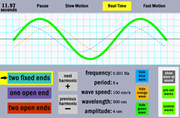 The Standing Wave Maker Interactive allows learners to investigate the formation of standing waves, the vibrational patterns associated with the various harmonics, and the difference between transverse and longitudinal standing waves. Learners can modify the frequency, amplitude, and speed of two component waves traveling along a string (or through a column of air) in opposite directions. The two waves are displayed in orange and blue and the resultant wave is displayed as a thick green line. Learners can also select a node or antinode as the end point of the wave. The animation can be shown in slow motion, regular speed, and fast motion. An option to display pre-set harmonics is also available. The Standing Wave Maker is an HTML5 simulation that excels at depicting the standing wave patterns for the various harmonics.
The Standing Wave Maker Interactive allows learners to investigate the formation of standing waves, the vibrational patterns associated with the various harmonics, and the difference between transverse and longitudinal standing waves. Learners can modify the frequency, amplitude, and speed of two component waves traveling along a string (or through a column of air) in opposite directions. The two waves are displayed in orange and blue and the resultant wave is displayed as a thick green line. Learners can also select a node or antinode as the end point of the wave. The animation can be shown in slow motion, regular speed, and fast motion. An option to display pre-set harmonics is also available. The Standing Wave Maker is an HTML5 simulation that excels at depicting the standing wave patterns for the various harmonics.
- PhET - Waves on a String
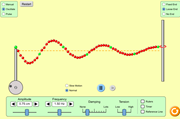 This HTML5 simulation models the motion of a wave through a string by the up-and-down vibrations of a set of 60 inter-connected harmonic oscillators. Learners can manually vibrate the first oscillator or have the vibrations automated. The simulation can be viewed at normal speed or in slow motion. A timer and background rulers can be toggled on and off. The tension and the amount of damping in the medium can be modified by the learner. The end of the string opposite the source can be set as a fixed or a free end.
This HTML5 simulation models the motion of a wave through a string by the up-and-down vibrations of a set of 60 inter-connected harmonic oscillators. Learners can manually vibrate the first oscillator or have the vibrations automated. The simulation can be viewed at normal speed or in slow motion. A timer and background rulers can be toggled on and off. The tension and the amount of damping in the medium can be modified by the learner. The end of the string opposite the source can be set as a fixed or a free end.
- A Standing Wave on a String
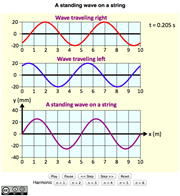 This simulation by Physics professor Andrew Duffy shows the formation of a standing wave pattern bu the interference of a rightward- and a leftward-moving wave. The standing wave pattern and the component waves are shown against the background grid that allows one to see the relative amplitude of the interfering wave and the resulting wave. Learners can alter the harmonic number to view the patterns for the first six harmonics. The animation can be paused, stepped forward frame-by-frame and played at normal speed.
This simulation by Physics professor Andrew Duffy shows the formation of a standing wave pattern bu the interference of a rightward- and a leftward-moving wave. The standing wave pattern and the component waves are shown against the background grid that allows one to see the relative amplitude of the interfering wave and the resulting wave. Learners can alter the harmonic number to view the patterns for the first six harmonics. The animation can be paused, stepped forward frame-by-frame and played at normal speed.
- Standing Wave
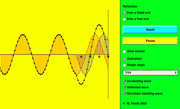 Walter Fendt's HTML5 simulation of a standing wave in a string depicts an incident wave, a reflected wave, and a standing wave formed in a string. Each wave is shown individually, beginning with the original incident wave. The end opposite the source can be fixed or free. The animation can be viewed at regular speed, in slow motion, or stepped through frame-by-frame. Learners can select from among four different frequencies.
Walter Fendt's HTML5 simulation of a standing wave in a string depicts an incident wave, a reflected wave, and a standing wave formed in a string. Each wave is shown individually, beginning with the original incident wave. The end opposite the source can be fixed or free. The animation can be viewed at regular speed, in slow motion, or stepped through frame-by-frame. Learners can select from among four different frequencies.
Video and Animations
- Hewitt Drewitt - Wave Interference
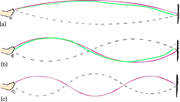 Textbook author Paul Hewitt explains the phenomenon of wave intereference and connects the topic of the formation of standing waves. The principle of superposition, constructive and destructive interference, standing waves and standing wave patterns, guitar strings, and other sound- and music-related phenomenon are introduced and explained. Featuring Dr. Hewitt's usual clear explanations, this 8-minute video will be suitable for students of all levels.
Textbook author Paul Hewitt explains the phenomenon of wave intereference and connects the topic of the formation of standing waves. The principle of superposition, constructive and destructive interference, standing waves and standing wave patterns, guitar strings, and other sound- and music-related phenomenon are introduced and explained. Featuring Dr. Hewitt's usual clear explanations, this 8-minute video will be suitable for students of all levels.
- Standing Waves
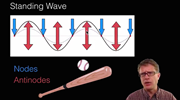 Paul Andersen of Bozeman Science explains how standing waves are created through the reflection and interference of traveling waves. the 5-minute video provides a great overview of standing waves, their parts, and their formation. Basic terminology is introduced and explained and numerous illustrations and demonstrations are provided. It is suitable for just about any level.
Paul Andersen of Bozeman Science explains how standing waves are created through the reflection and interference of traveling waves. the 5-minute video provides a great overview of standing waves, their parts, and their formation. Basic terminology is introduced and explained and numerous illustrations and demonstrations are provided. It is suitable for just about any level.
- The Physics of Playing Guitar
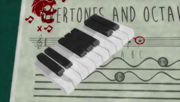 This 5-minute TED_Ed video explains the physics associated with guitars. The role of the sound box, the reason for varying string thickness, the role of frets and the reason for their spacing distance, and the connection between guitars and other stringed instruments is discussed. Amplitude, frequency, standing waves, nodes, antinodes, harmonics, octaves, beats, and other physics phenomenon are explained in the context of guitar playing.
This 5-minute TED_Ed video explains the physics associated with guitars. The role of the sound box, the reason for varying string thickness, the role of frets and the reason for their spacing distance, and the connection between guitars and other stringed instruments is discussed. Amplitude, frequency, standing waves, nodes, antinodes, harmonics, octaves, beats, and other physics phenomenon are explained in the context of guitar playing.
- Standing Wave Animation
 Desmos is a free online Graphing Calculator that has numerous capabilities that are useful to physics teachers. The Physics Classroom's Standing Wave Formation Desmos file features several of these capabilities. The Graphing file is set to animate a standing wave by scrolling a paramer value between a pre-set minimum and maximum value. Physics teachers will find it helpful for demonstrating how a standing wave is formed by the superposition of two interfering waves. It's HTML5 - works on tablets such as the iPad, on Chromebooks, and on smart phones.
Desmos is a free online Graphing Calculator that has numerous capabilities that are useful to physics teachers. The Physics Classroom's Standing Wave Formation Desmos file features several of these capabilities. The Graphing file is set to animate a standing wave by scrolling a paramer value between a pre-set minimum and maximum value. Physics teachers will find it helpful for demonstrating how a standing wave is formed by the superposition of two interfering waves. It's HTML5 - works on tablets such as the iPad, on Chromebooks, and on smart phones.
Labs and Investigations
- The Physics Classroom, The Laboratory, Harmonic Frequencies Lab
Students use a mechanical oscillator and string to discover the relationship between the fundamental frequency, harmonic number, and the frequencies of other harmonics.
Link: http://www.physicsclassroom.com/lab/waves/Wlabs.html
- The Physics Classroom, The Laboratory, Guitar String Lab
Students use a mechanical oscillator and string to explore the relationship between the length of the string and the frequencies of the harmonics and the speed at which waves move along the string.
Link: http://www.physicsclassroom.com/lab/sound/Slabs.html
Demonstration Ideas
- Gum Drop Wave Machine
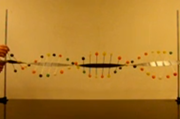 With some duct tape, $2 worth of candy, and some skewer sticks from the local party store, you can make a real "sweet-looking" wave machine. Shake it at just the right frequency and you can get it to vibrate with one of its harmonic patterns. Our YouTube video shows the end product in action as it used to demonstrate the formation of the third harmonic standing wave pattern with three antinodes vibrating up and down from a high to a low point. The video was taken with a high speed camera.
With some duct tape, $2 worth of candy, and some skewer sticks from the local party store, you can make a real "sweet-looking" wave machine. Shake it at just the right frequency and you can get it to vibrate with one of its harmonic patterns. Our YouTube video shows the end product in action as it used to demonstrate the formation of the third harmonic standing wave pattern with three antinodes vibrating up and down from a high to a low point. The video was taken with a high speed camera.
- Wave Reflection and Standing Waves
 James Lincoln of UCLA Physics Videos uses a snakey to demonstrate how reflected waves at a fixed end can interfere with incident waves from a source to produce a standing wave interference pattern. The demonstrations shown in this short 45-second video can easily be repeated live before students with simple and inexpensive equipment.
James Lincoln of UCLA Physics Videos uses a snakey to demonstrate how reflected waves at a fixed end can interfere with incident waves from a source to produce a standing wave interference pattern. The demonstrations shown in this short 45-second video can easily be repeated live before students with simple and inexpensive equipment.
Minds On Physics Internet Modules:
The Minds On Physics Internet Modules are a collection of interactive questioning modules that target a student’s conceptual understanding. Each question is accompanied by detailed help that addresses the various components of the question.
- Wave Motion, Ass’t WM7 - Mathematics of Standing Waves 1
- Wave Motion, Ass’t WM8 - Mathematics of Standing Waves 2
- Sound and Music, Ass’t SM6 - Harmonics of Stringed Instruments
- Sound and Music, Ass’t SM7 - Mathematics of Stringed Instruments
Concept Building Exercises
- The Curriculum Corner, Wave Basics, Standing Wave Mathematics
Link: http://www.physicsclassroom.com/curriculum/waves
- The Curriculum Corner, Sound and Music, Resonance
- The Curriculum Corner, Sound and Music, Resonance and Guitar Strings
Link: http://www.physicsclassroom.com/curriculum/sound
Problem-Solving Exercises
- The Calculator Pad, Wave Basics, Problems #18 - #27
Link: http://www.physicsclassroom.com/calcpad/waves/problems
Science Reasoning Activities
- Standing Waves on a Rope
Link: http://www.physicsclassroom.com/reasoning/waves
Common Misconceptions
- Antinodes, Crests, and Troughs
Students can often become confused with what they are seeing when they view a standing wave pattern. It will take some time and some reinforcement before they become comfortable with the terms nodes and antinodes. Many will view the antinode as a crest or as a trough. It is instructive to emphasize that a standing wave is not actually a wave but rather a wave pattern that results from the interference of two waves. Taking time to show and to explain how this works will help with their comprehension. And be careful with your language as you discuss these creatures; referring to them as standing wave patterns and not standing waves will help students avoid such confusions. It is also instructive to draw the pattern such that the shape of the medium at one point in time and one-half cycle later are displayed. Emphasize that the point we call an antinode is actually oscillating back and forth from a large + displacement to a large - displacement. Helping students to recognize that this antinodal point can be both "up" and "down" (one half-cycle later) will assist students in not calling it a crest or a trough.
- Identifying a Wavelength on a Standing Wave Pattern
It is important that students be able to identify the distance from an antinode to the next adjacent antinode on a standing wave pattern as being equal to one-half wavelength. The task of determining the wavelength from the pattern is largely dependent upon this visual skill. It is helpful to trace over the standing wave pattern beginning at the antinodal point and counting out "half" or "quarter" wavelengths as you trace over the line. It is also helpful to do the counting with a still-frame of one of the simulations described above.
Standards:
A. Next Generation Science Standards (NGSS)
Disciplinary Core Ideas
- HS-PS4-1 The wavelength and frequency of a wave are related to one another by the speed of travel of the wave, which depends on the type of wave and the medium through which it is passing.
Crosscutting Concepts
Patterns
- Mathematical representations are needed to identify some patterns.
Scale, Proportion, and Quantity
- Algebraic thinking is used to examine scientific data and predict the effect of a change in one variable on another (e.g., linear growth vs. exponential growth).
Systems and System Models
- Models (e.g., physical, mathematical, computer models) can be used to simulate systems and interactions—including energy, matter, and information flows—within and between systems at different scales.
- When investigating or describing a system, the boundaries and initial conditions of the system need to be defined and their inputs and outputs analyzed and described using models.
Science and Engineering Practices
Practice #2: Developing and Using Models
- Develop and/or use a model (including mathematical and computational) to generate data to support explanations, predict phenomena, analyze systems, and/or solve problems.
Practice #3: Planning and Carrying Out Investigations
- Select appropriate tools to collect, record, analyze, and evaluate data.
- Make directional hypotheses that specify what happens to a dependent variable when an independent variable is manipulated.
Practice #5: Using Mathematics and Computational Thinking
- Use mathematical, computational, and/or algorithmic representations of phenomena or design solutions to describe and/or support claims and/or explanations.
- Apply techniques of algebra and functions to represent and solve scientific and engineering problems.
Practice #7: Engaging in Argument from Evidence
- Make and defend a claim based on evidence about the natural world or the effectiveness of a design solution that reflects scientific knowledge and student-generated evidence.